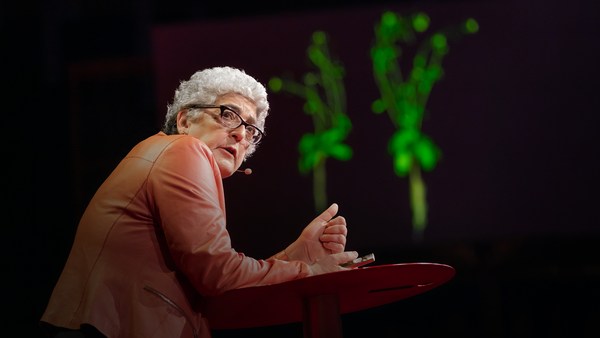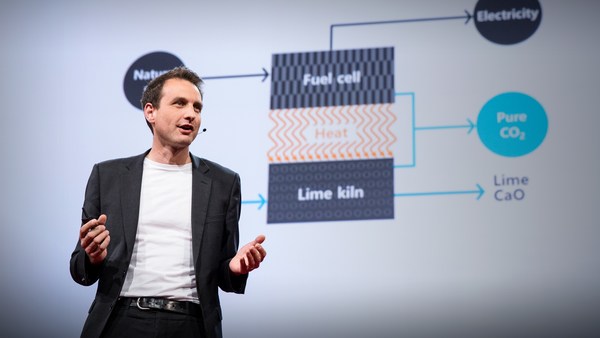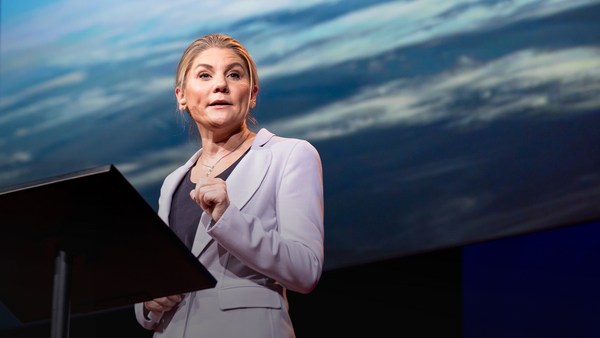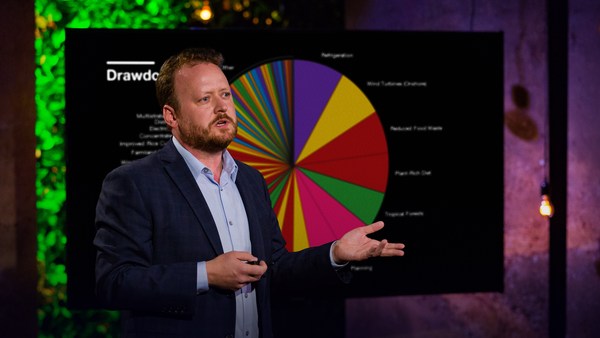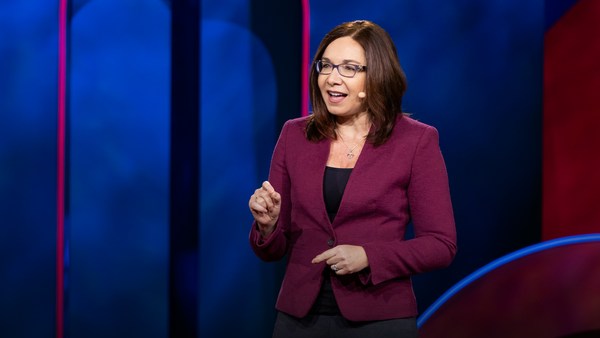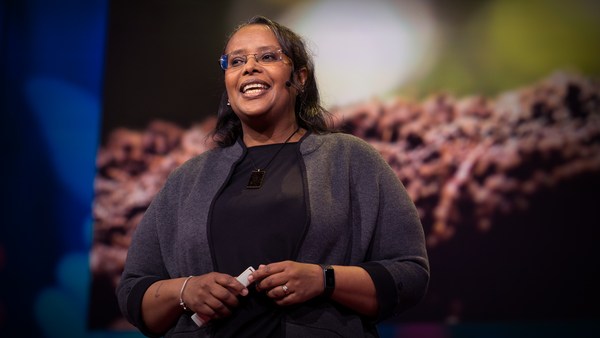Oh, there's a lot of it. This is seaweed. It's pretty humble stuff. But it does have some remarkable qualities. For one, it grows really fast. So the carbon that is part of that seaweed, just a few weeks ago, was floating in the atmosphere as atmospheric CO2, driving all the adverse consequences of climate change. For the moment, it's locked safely away in the seaweed, but when that seaweed rots -- and by the smell of it, it's not far away -- when it rots, that CO2 will be released back to the atmosphere. Wouldn't it be fantastic if we could find a way of keeping that CO2 locked up long-term, and thereby significantly contributing to solving the climate problem?
What I'm talking about here is drawdown. It's now become the other half of the climate challenge. And that's because we have delayed so long, in terms of addressing climate change, that we now have to do two very big and very difficult things at once. We have to cut our emissions and clean our energy supply at the same time that we draw significant volumes of carbon dioxide out of the atmosphere. If we don't do that, about 25 percent of the CO2 we put in the air will remain there, by human standards, forever. So we have to act.
This is really a new phase in addressing the climate crisis and it demands new thinking. So, ideas like carbon offsets really don't make sense in the modern era. You know, when you offset something, you say, "I'll permit myself to put some greenhouse gas into the atmosphere, but then I'll offset it by drawing it down." When you've got to both cut your emissions and draw down CO2, that thinking doesn't make sense anymore. And when we're talking about drawdown, we're talking about putting large volumes of greenhouses gases, particularly CO2, out of circulation. And to do that, we need a carbon price. We need a significant price that we'll pay for that service that we'll all benefit from.
We've made almost no progress so far with the second half of the climate challenge. It's not on most people's radar. And, you know, I must say, at times, I hear people saying, "I've lost hope that we can do anything about the climate crisis." And look, I've had my sleepless nights too, I can tell you. But I'm here today as an ambassador for this humble weed, seaweed. I think it has the potential to be a big part of addressing the challenge of climate change and a big part of our future.
Now, what the scientists are telling us we need to do over the next 80-odd years to the end of this century, is to cut our greenhouse gas emissions by three percent every year, and draw three gigatons of CO2 out of the atmosphere every year. Those numbers are so large that they baffle us. But that's what the scientists tell us we need to do. I really hate showing this graph, but I'm sorry, I have to do it. It is very eloquent in terms of telling the story of my personal failure in terms of all the advocacy I've done in climate change work and in fact, our collective failure to address climate change. You can see our trajectory there in terms of warming and greenhouse gas concentrations. You can see all of the great scientific announcements that we've made, saying how much danger we face with climate change. You can see the political meetings. None of it has changed the trajectory. And this is why we need new thinking, we need a new approach.
So how might we go about drawing down greenhouse gases at a large scale? There's really only two ways of doing it, and I've done a very deep dive into drawdown. And I'll preempt my -- And I would say this stuff comes up smelling like roses at the end of the day. It does, it's one of the best options, but there are many, many possibilities. There are chemical pathways and biological pathways. So two ways, really, of getting the job done.
The biological pathways are fantastic because the energy source that's needed to drive them, the sun, is effectively free. We use the sun to drive photosynthesis in plants, break apart that CO2 and capture the carbon. There are also chemical pathways. They sound ominous, but actually, they're not bad at all. The difficulty they face is that we have to actually pay for the energy that's required to do the job or pay to facilitate that energy. Direct air capture is a great example of a chemical pathway, and people are using that right now to take CO2 out of the atmosphere and manufacture biofuels or manufacture plastics. Great progress is being made, but it will be many decades before those chemical pathways are drawing down a gigaton of CO2 a year.
The biological pathways offer us a lot more hope, I think, in the short term. You've probably heard about reforestation, planting trees, as a solution to the climate problem. You know, it's a fair question: Can we plant our way out of this problem by using trees? I'm skeptical about that for a number of reasons. One is just the scale of the problem. All trees start as seeds, little tiny things, and it's many decades before they've reached their full carbon-capture potential. And secondly, if you look at the land surface, you see that it's so heavily utilized. We get our food from it, we get our forestry products from it, biodiversity protection and water and everything else. To expect that we'll find enough space to deal with this problem, I think is going to be quite problematic.
But if we look offshore, wee see a solution where there's already an existing industry, and where there's a clearer way forward. The oceans cover about 70 percent of our planet. They play a really big role in regulating our climate, and if we can enhance the growth of seaweed in them, we can use them, I think, to develop a climate-altering crop. There are so many different kinds of seaweed, there's unbelievable genetic diversity in seaweed, and they're very ancient; they were some of the first multicellular organisms ever to evolve. People are using special kinds of seaweed now for particular purposes, like developing very high-quality pharmaceutical products. But you can also use seaweed to take a seaweed bath, it's supposed to be good for your skin; I can't testify to that, but you can do it. The scalability is the big thing about seaweed farming.
You know, if we could cover nine percent of the world's ocean in seaweed farms, we could draw down the equivalent of all of the greenhouse gases we put up in any one year, more than 50 gigatons. Now, I thought that was fantastic when I first read it, but I thought I'd better calculate how big nine percent of the world's oceans is. It turns out, it's about four and a half Australias, the place I live in. And how close are we to that at the moment? How many ocean-going seaweed farms do we actually have out there? Zero. But we do have some prototypes, and therein lies some hope.
This little drawing here of a seaweed farm that's currently under construction tells you some very interesting things about seaweed. You can see the seaweed growing on that rack, 25 meters down in the ocean there. It's really different from anything you see on land. And the reason being that, you know, seaweed is not like trees, it doesn't have nonproductive parts like roots and trunks and branches and bark. The whole of the plant is pretty much photosynthetic, so it grows fast. Seaweed can grow a meter a day.
And how do we sequester the carbon? Again, it's very different from on land. All you need to do is cut that seaweed off -- drifts into the ocean abyss, Once it's down a kilometer, the carbon in that seaweed is effectively out of the atmospheric system for centuries or millennia. Whereas if you plant a forest, you've got to worry about forest fires, bugs, etc., releasing that carbon. The key to this farm, though, is that little pipe going down into the depths. You know, the mid-ocean is basically a vast biological desert. There's no nutrients there that were used up long ago. But just 500 meters down, there is cool, very nutrient-rich water. And with just a little bit of clean, renewable energy, you can pump that water up and use the nutrients in it to irrigate your seaweed crop. So I think this really has so many benefits. It's changing a biological desert, the mid-ocean, into a productive, maybe even planet-saving solution.
So what could go wrong? Well, anything we're talking about at this scale involves a planetary-scale intervention. And we have to be very careful. I think that piles of stinking seaweed are probably going to be the least of our problems. There's other unforeseen things that will happen. One of the things that really worries me, when I talk about this, is the fate of biodiversity in the deep ocean. If we are putting gigatons of seaweed into the deep ocean, we're affecting life down there.
The good news is that we know that a lot of seaweed already reaches the deep ocean, after storms or through submarine canyons. So we're not talking about a novel process here; we are talking about enhancing a natural process. And we'll learn as we go. I mean, it may be that these ocean-going seaweed farms will need to be mobile, to distribute the seaweed across vast areas of the ocean, rather than creating a big stinking pile in one place. It may be that we'll need to char the seaweed -- so create a sort of an inert, mineral biochar before we dispatch it into the deep. We won't know until we start the process, and we will learn effectively by doing.
I just want to take you to contemporary seaweed farming. It's a big business -- it's a six-billion-dollar-a-year business. These seaweed farms off South Korea -- you can see them from space, they are huge. And they're increasingly not just seaweed farms. What people are doing in places like this is something called ocean permaculture. And in ocean permaculture, you grow fish, shellfish and seaweed all together. And the reason it works so well is that the seaweed makes the seawater less acid. It provides an ideal environment for growing marine protein. If we covered nine percent of the world's oceans in ocean permaculture, we would be producing enough protein in the form of fish and shellfish to give every person in a population of 10 billion 200 kilograms of high-quality protein per year. So, we've got a multipotent solution here. We can address climate change, we can feed the world, we can deacidify the oceans.
The economics of all of this is going to be challenging. We'll be investing many, many billions of dollars into these solutions, and they will take decades to get to the gigaton scale. The reason that I'm convinced that this is going to happen is that unless we get the gas out of the air, it is going to keep driving adverse consequences. It will flood our cities, it will deprive us of food, it will cause all sorts of civil unrest. So anyone who's got a solution to dealing with this problem has a valuable asset. And already, as I've explained, ocean permaculture is well on the road to being economically sustainable. You know, in the next 30 years, we have to go from being a carbon-emitting economy to a carbon-absorbing economy. And that doesn't seem like very long. But half of the greenhouse gases that we've put into the atmosphere, we've put there in the last 30 years.
My argument is, if we can put the gas in in 30 years, we can pull it out in 30 years. And if you doubt how much can be done over 30 years, just cast your mind back a century, to 1919, compare it with 1950. Now, in 1919, here in Edinburgh, you might have seen a canvas and wood biplane. Thirty years later, you'd be seeing jet aircraft. Transport in the street were horses in 1919. By 1950, they're motor vehicles. 1919, we had gun powder; 1950, we had nuclear power. We can do a lot in a short period of time. But it all depends upon us believing that we can find a solution.
Now what I would love to do is bring together all of the people with knowledge in this space. The engineers who know how to build structures offshore, the seaweed farmers, the financiers, the government regulators, the people who understand how things are done. And chart a way forward, say: How do we go from the existing six-billion-dollar-a-year, inshore seaweed industry, to this new form of industry, which has got so much potential, but will require large amounts of investment? I'm not a betting man, you know. But if I were, I'll tell you, my money would be on that stuff, it would be on seaweed. It's my hero.
Thank you.
(Applause)
